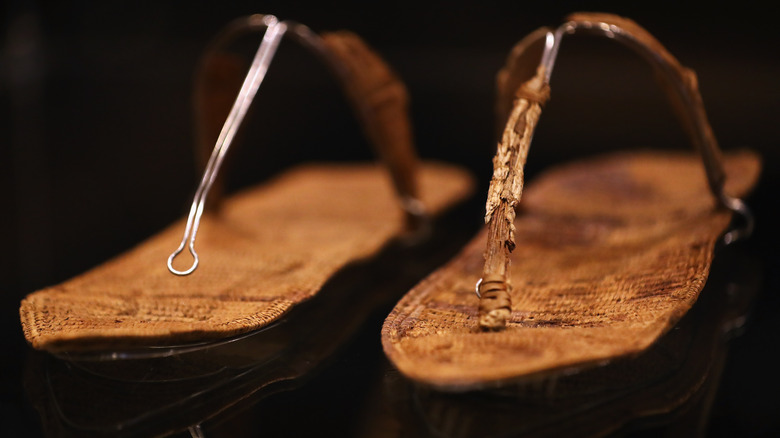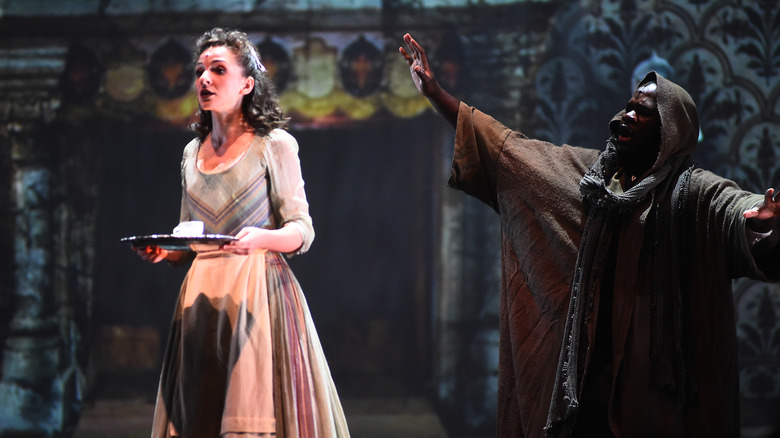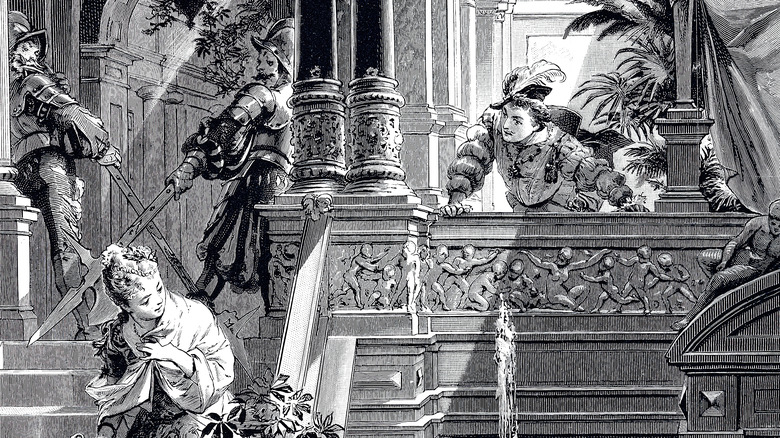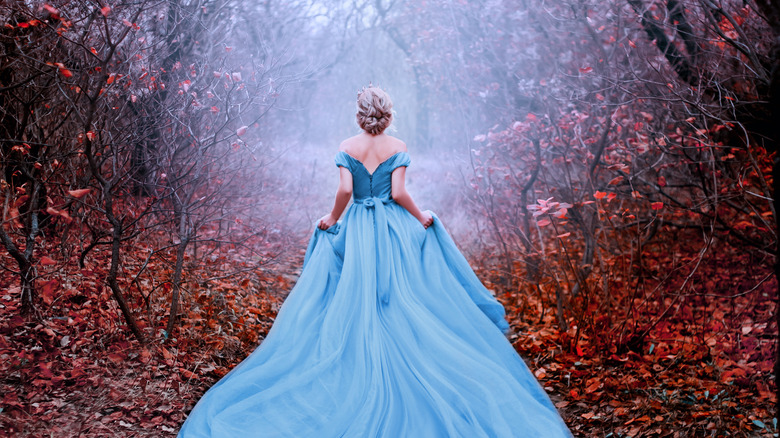The Messed Up Origins Of Disney's Cinderella
We may receive a commission on purchases made from links.
Disney's had a habit the past, oh, 80 years or so of spinning various traditional fairy tales and regional folklores into money-printing animated films. "Aladdin" comes from the ancient compilation of Arabic folktales "One Thousand and One Nights," "The Little Mermaid" pulls from Hans Christian Andersen's 1836 short story, "Moana" takes broad inspiration from Polynesian lore and oceanic culture, and so forth. Of course, Disney's source material receives the typical window dressing of unobjectionable themes like finding oneself, sticking to one's dreams, discovering true love, and all that. And in all cases, the studio adjusts the content to make it more or less age appropriate. After all, some of its movies are based on some seriously dark stories.
Such is the case with 1950's "Cinderella," one of Disney's classic animated films featuring all the facets of the story we know so well: The mistreated young woman, the wicked stepmother, the fairy godmother, the pumpkin carriage, the prince, the glass slipper, etc. Like other Disney-adapted works, its version has all but eclipsed the original. But, of course, earlier tales of Cinderella weren't so sweet and bibbidi-bobbidi-boo-y.
At least, the grim Brothers Grimm version wasn't so sweet and bibbidi-bobbidi-boo-y. The pair wrote and rewrote stories into cautionary, kid-centric tales that often included brutal elements like Hansel and Gretel shoving a witch into an oven. Moral lessons, indeed. But before we get to that version — named "Aschenputtel" and released in 1812 — we've got a 3rd-century B.C.E. iteration from Italy, a 9th-century C.E. renditions from China, loads of 17th-century Western Europe accounts, and more. None are rated G, and one is certainly blood-soaked.
The Roman version of the tale
It's safe to say that the Roman account of Rhodopis the Egyptian courtesan falls within the Cinderella-like cluster of stories. It has the same basic points as later iterations. Yet some historians have waded deep into the historical weeds to point out that no, this Roman version didn't serve as direct inspiration for later retellings like that from the Brothers Grimm. That's fine if true, because that's not this article's point. It actually might be more interesting to have apparently disconnected, cross-cultural iterations of the same tale. As though the idea of a lower-class girl getting inducted into aristocracy via a personal item and natural beauty is a shared archetype. And while such older, pre-Disney versions might qualify as quaint little stories, none of them are meant to entertain children.
The tale of Rhodopis was written as part of a "light reading" compilation for 3rd-century C.E. Romans and was indeed considered a charming little yarn, as the Loeb Classical Library says. From Claudius Aelianus' volume "Various History," the single-paragraph narrative is set in ancient Egypt and was first translated into English in 1666. In the story, one of Rhodopis' shoes gets snatched up by an eagle while she's taking a bath and carried away to Memphis. There, it's dropped in the lap of the 7th-century B.C.E. pharaoh Psammetichus (sometimes spelled Psamtik). He dispatches minions throughout Egypt to find the shoe's owner, Rhodopis gets brought to him, he marvels at her beauty, and they get married.
The Chinese take on the story
A Cinderella story need not contain every single element of the familiar Disney tale or any other in order to qualify as one. But in the case of "Ye Xian," written by Tang-era Chinese author Duan Chengshi in 860 C.E., lots of recognizable elements show up. A girl whose father dies, a mean stepmother, a magical protector, a party where the main character appears in a beautiful dress, and the whole lost shoe and marriage into royalty thing. Also, there's a spiritual fish guardian who gets stabbed and eaten, an ancestral spirit visitation, a magical bone-burying ritual, and more. It's not gruesome or anything, and could certainly be spun as a kid's story. But like before, that wasn't the intention.
Much like other versions of the tale, Ye Xian is depicted as far more beautiful and smart than her stepsisters. In what becomes a story about worthy people getting their due, the spirit of Ye Xian's mother sends the aforementioned fish guardian to guide her. That's when the oppressive stepmother kills the fish, transforms it into dinner, and Ye Xian gets a visit from an ancestral spirit akin to Disney's fairy godmother. The being helps her conduct a magic ritual using the fish's bones to invoke the power of its wish-granting spirit. From here, she wishes her way into a beautiful dress and golden slippers at a New Year's festival, but ultimately races away when her stepfamily recognizes her, leaving her slippers behind. The shoes make their way to the king, Ye Xian follows, and the king marries her.
Italy's 'Cenerentola' and France's 'Cendrillon'
While we still haven't gotten to the truly gristly, gruesome, and Grimm version of Cinderella, by the time we get to 17th-century Italy, we're on track. The Abilene, Texas Public Library says that researchers have identified at least 345 different Cinderella variants across Europe, all containing the evil female relative, magical gala, and a critical Disney component: A time limit for the magic. But it's two Cinderella tales in particular that stand head-and-shoulders above the rest in terms of impact.
The first comes from Italian author Giambattista Basile in his 1634 collection of short stories, "Lo cunto de li cunti" ("The Story of Stories"). In this version, the stepmother of a girl named Zezolla transforms her into a rag-wearing servant and dubs her "Cenerentola" (aka "Cat Cinderella," because she's so crafty). But in this iteration (twist incoming), the mean stepmother begins as Zezolla's governess and convinces the child to murder her first stepmother. The teacher marries Zezolla's father and becomes her new guardian, but she's just as mean as the first. No worries, though — the king marries Cinderella in this one, too.
A scant three years later, in 1637, French author Charles Perrault published the beloved "Mother Goose's Fairy Tales," which contains the version of Cinderella that we all know. This story introduces ultra-specific elements like a fairy godmother, a pumpkin transformed into a carriage, mice who turn into horses, and the whole glass slipper bit. Perrault might not have known it, but he more or less Disneyfied Cinderella over 300 years before Disney did in 1950.
The Brothers Ultra-Grimmdark
Now we come to the Cinderella story that stands out for how strangely violent it is. Not everywhere, mind, but toward the end. We're speaking of "Aschenputtel" by Jacob and Wilhelm Grimm, who drew on Charles Perrault and Giambattista Basile's Cinderellas to make their own grindhouse-lite version in 1812.
"Aschenputtel" is very different from the Perrault and Basile stories in narrative and tone, and it feels far less formulaic. Even the tales of Ye Xian and Rhodopis are closer to the familiar Disney version. In "Aschenputtel," Cinderella mourns her dead mother so keenly that her tears grow a tree from the soil. White pigeons, meanwhile, answer her wishes when she prays at the tree. This is likely a Holy Spirit reference, as the Brothers Grimm were raised strict Lutherans. Later on, a king holds a festival, the birds produce clothing and slippers for Cinderella, she attends the event, catches the attention of the prince, and then we get to the gruesome slippers-trying-on sequence.
In order to make her daughters' feet fit Cinderella's slippers, the wicked stepmother orders one of them to cut off a toe and the other a chunk of their heel. The prince doesn't buy it, Cinderella tries on the slippers, and voila: They get married. Then we come across a small outro at the end saying that the pigeons pecked out the eyes of the stepsisters at the wedding. "Thus, for their wickedness and falsehood," the story ends, "they were punished with blindness as long as they lived."
Disney's take on the tale
Following the success of 1937's "Snow White and the Seven Dwarfs," Disney decided to pump out animated feature films one after another. All of these movies have gone on to become classics in the studio's canon: Pinocchio (1940), Fantasia (1940), Dumbo (1941), and Bambi (1942). After this, Disney took a break from the big features because of World War II economic troubles. Come the end of the '40s, the company was ready for its next big feature. For this, it turned to the Grimm well it had tapped for "Snow White and the Seven Dwarfs" (or "Little Snow-White," as the Brothers named it).
But as we all know, Disney didn't include any self-maiming or bird-blinded stepsisters in its version. As mentioned, Disney's 1950 "Cinderella" most closely resembles the 1637 Charles Perrault take in "Mother Goose's Fairy Tales." It also included musical numbers that sound like summaries of Disney's entire animated ethos, e.g., "A Dream Is a Wish Your Heart Makes." The studio chose "Cinderella" because of parallels to "Snow White:" A young and mistreated heroine, an oppressive matriarch, funny little companions (mice and dwarves), a prince to the rescue, and so forth. Plus, "Cinderella" gave audiences a proverbial happy ending and blissful marriage. Everything falls into place perfectly for the kind and noble people, and the mean stepmother and stepsisters are sort of just hand-waved and forgotten. We're not sure the Brothers Grimm would approve of the lack of divine retribution, but at least kids will like it.





